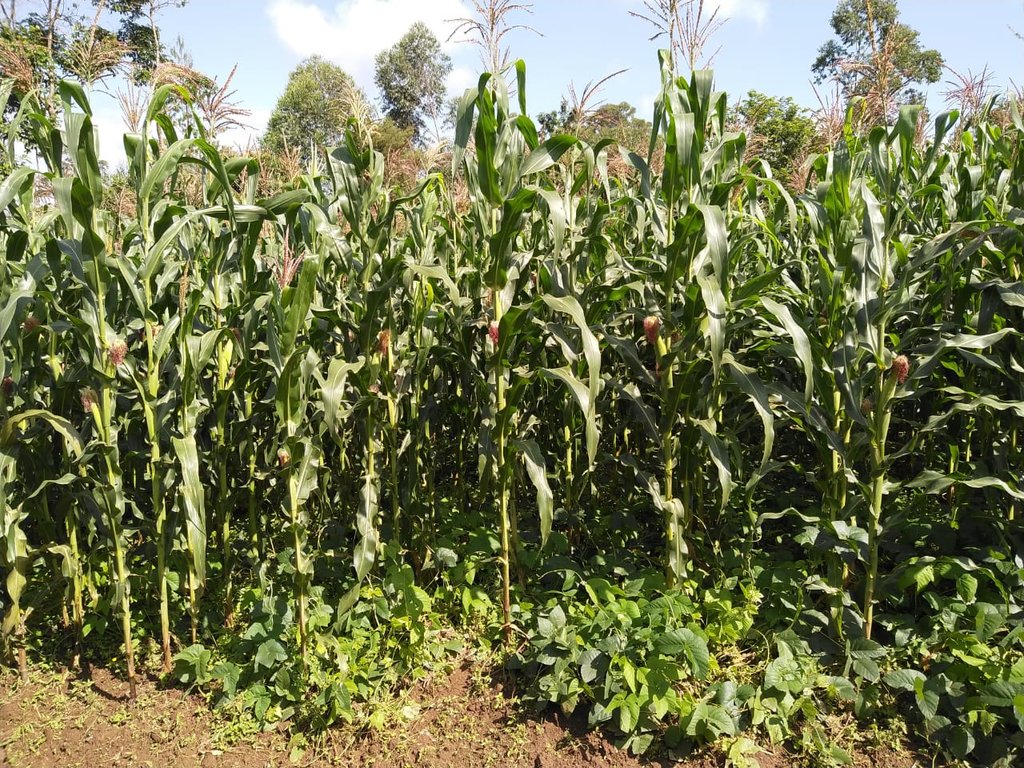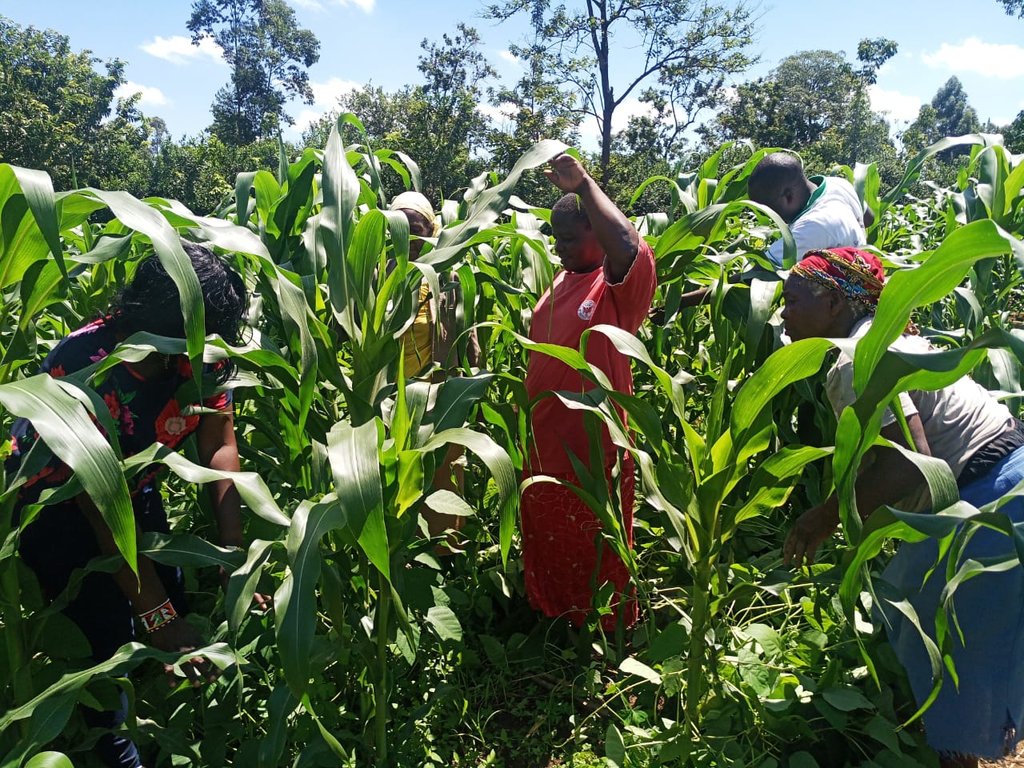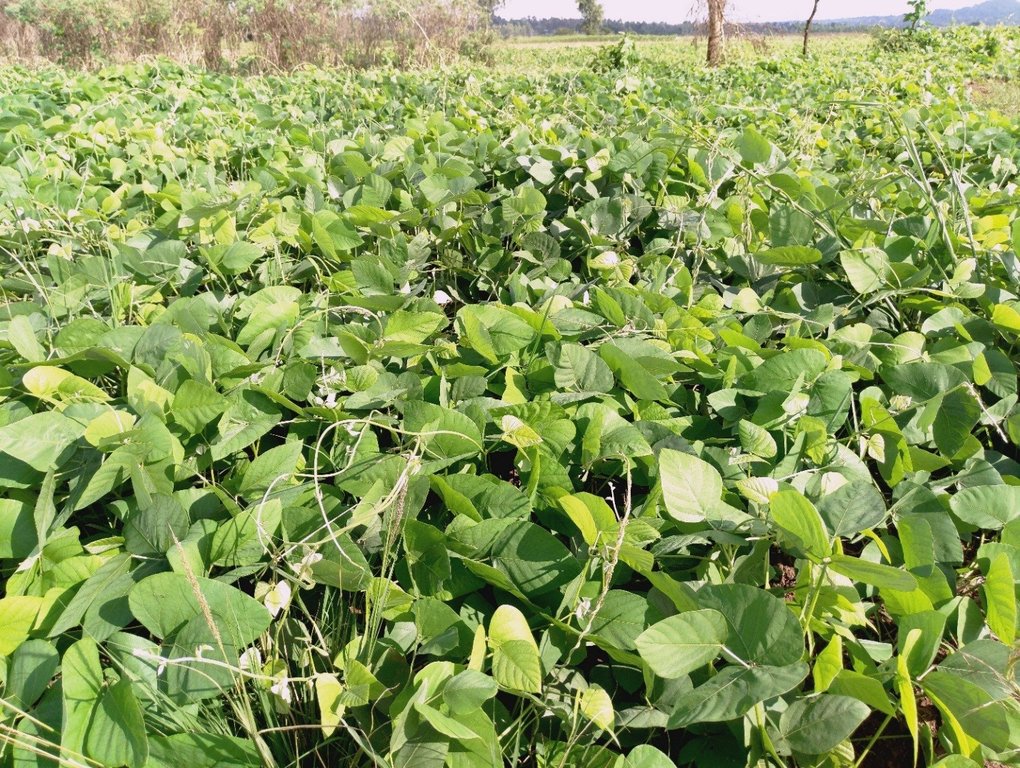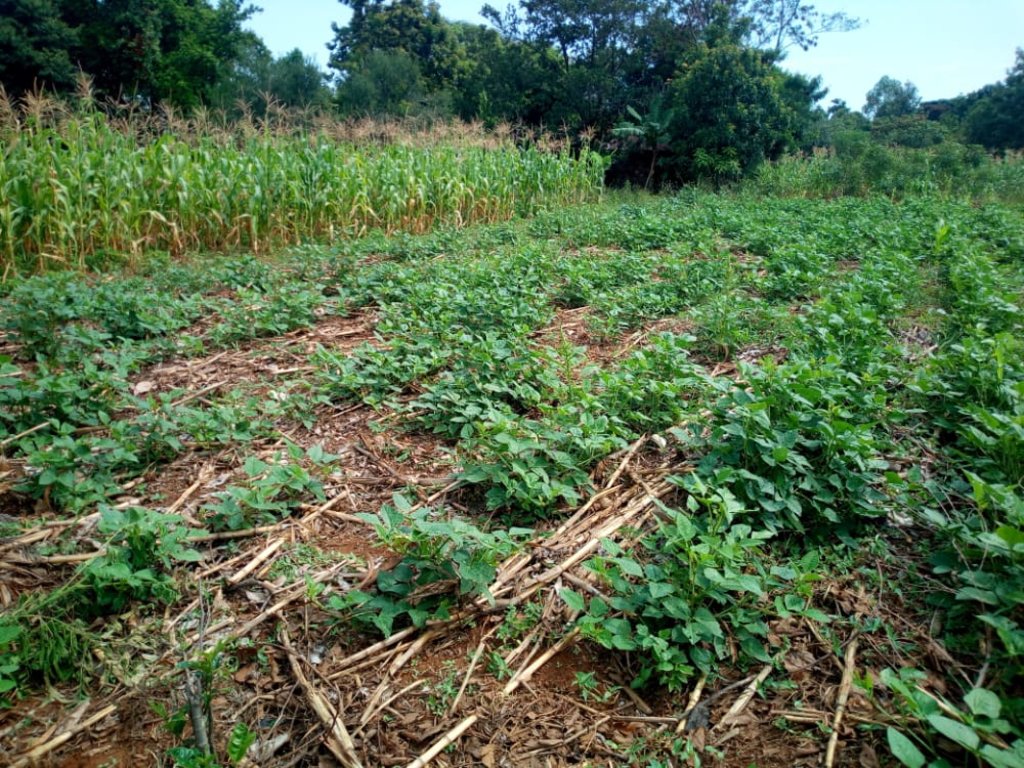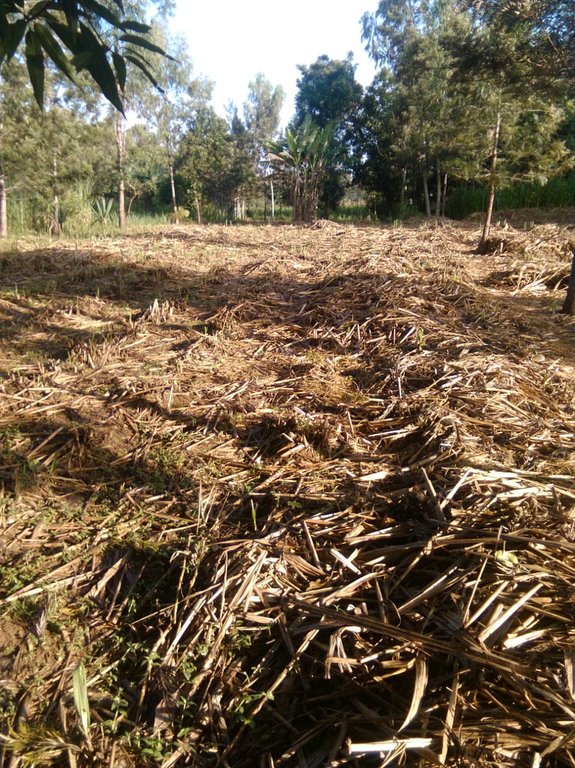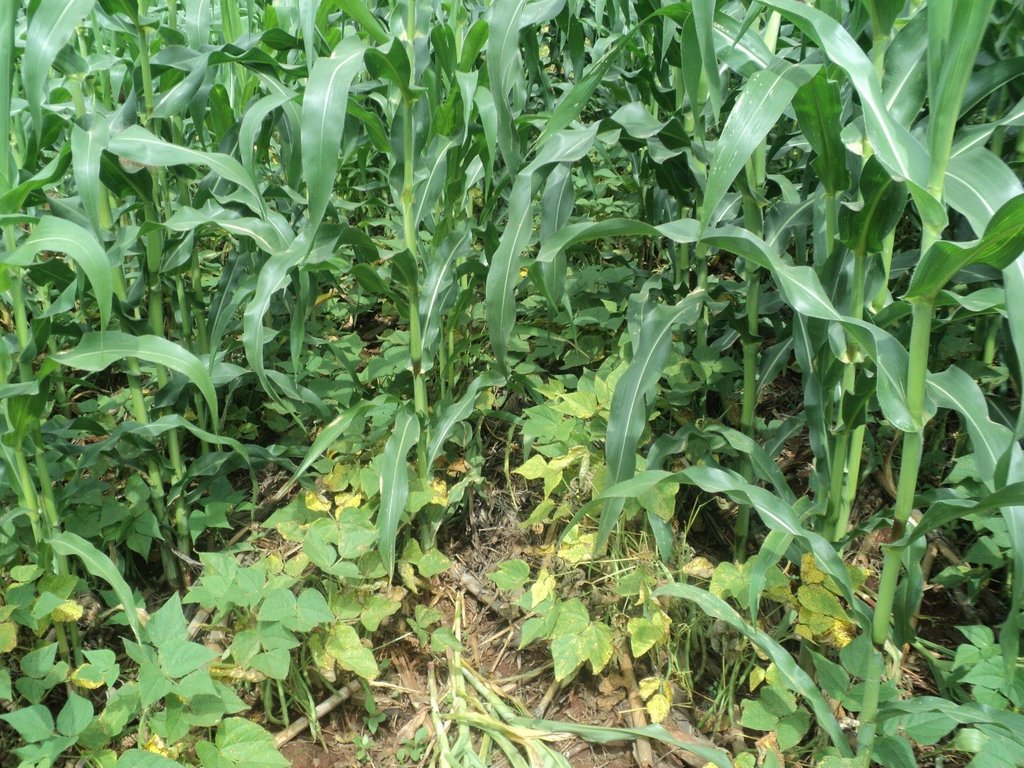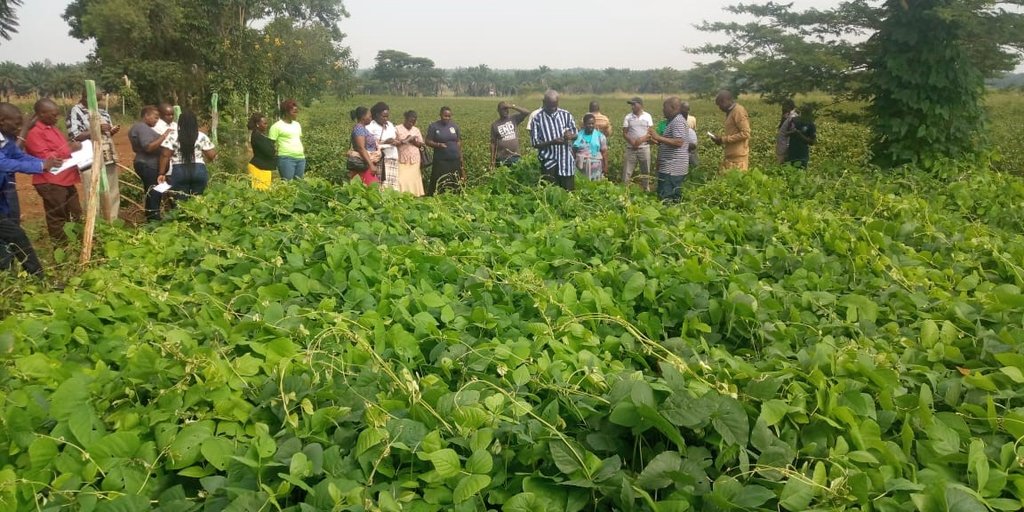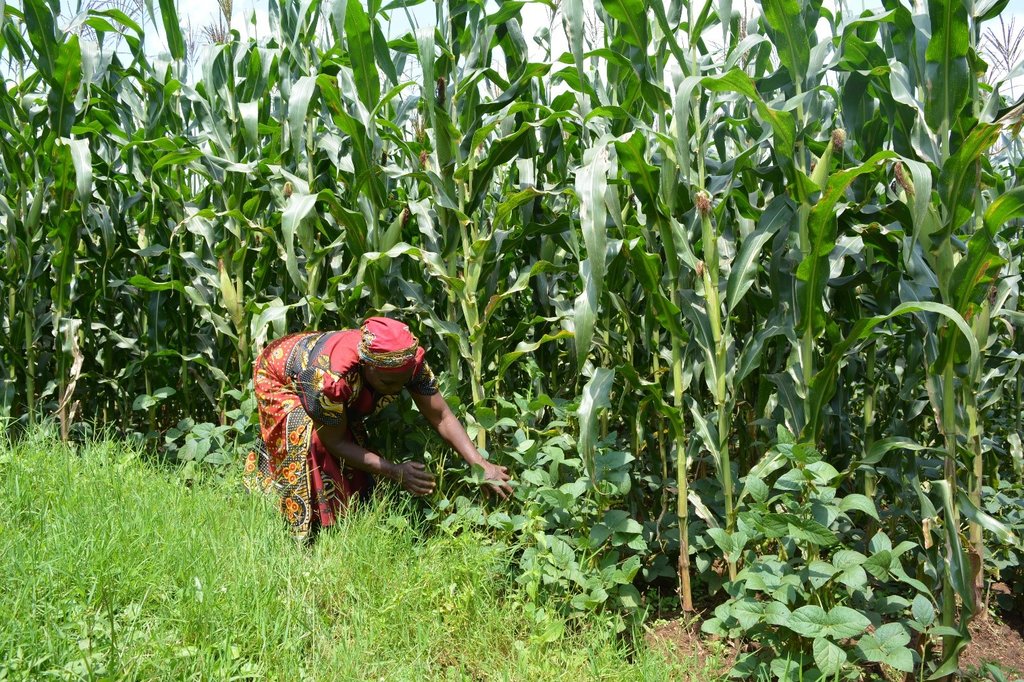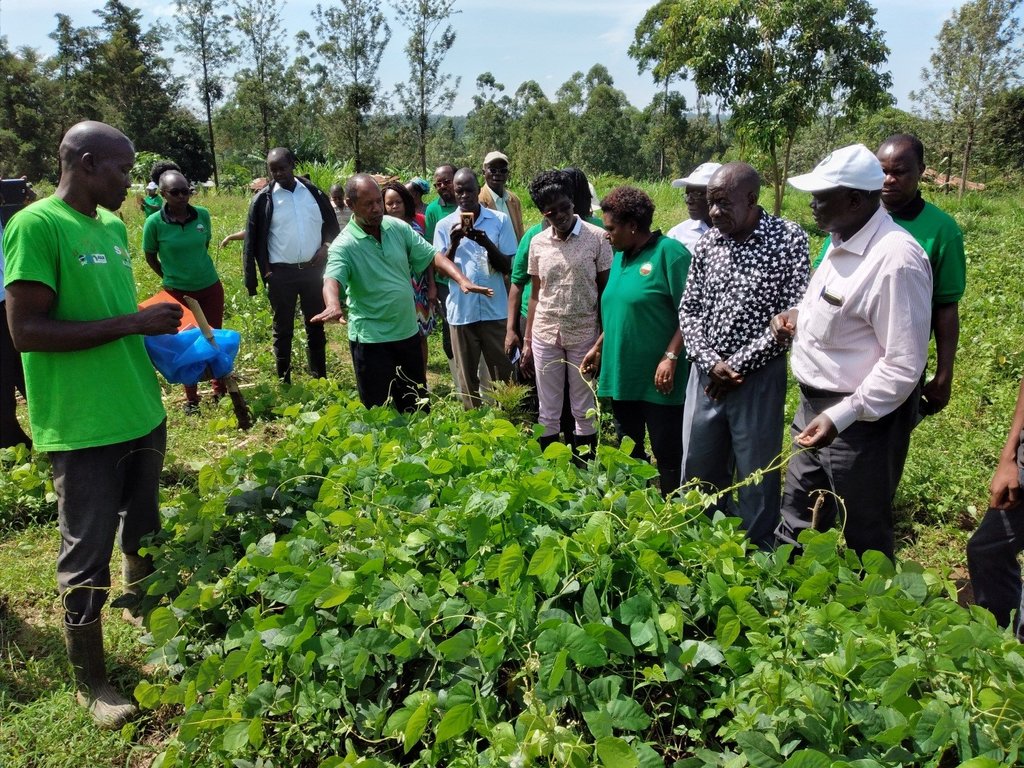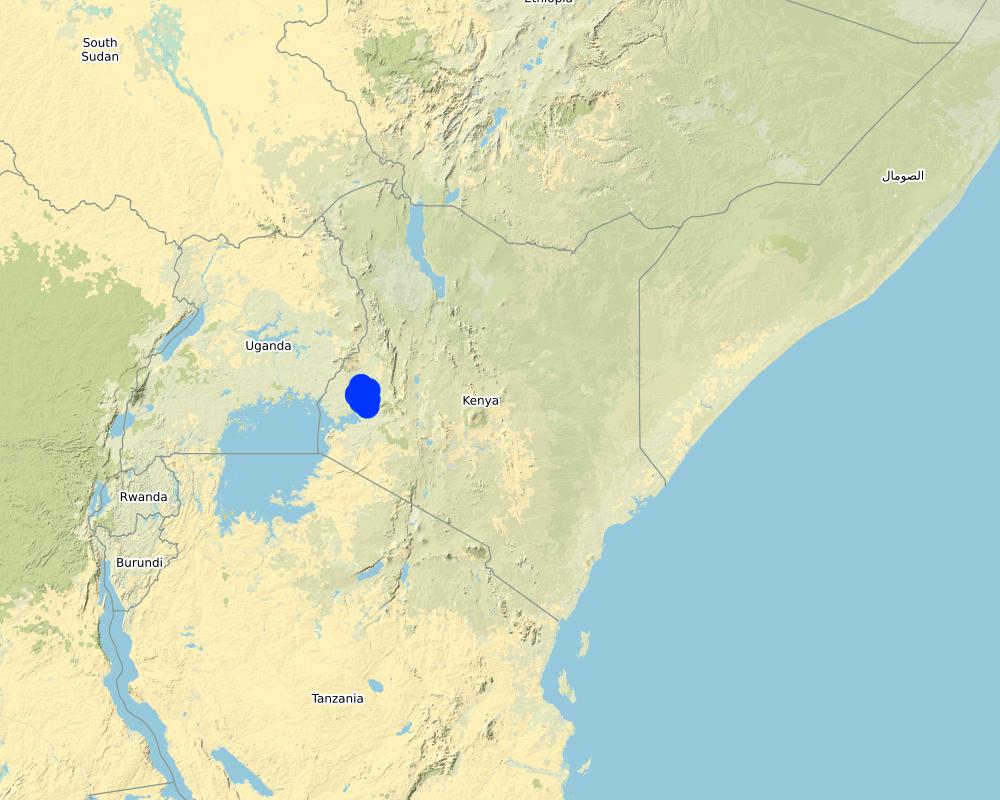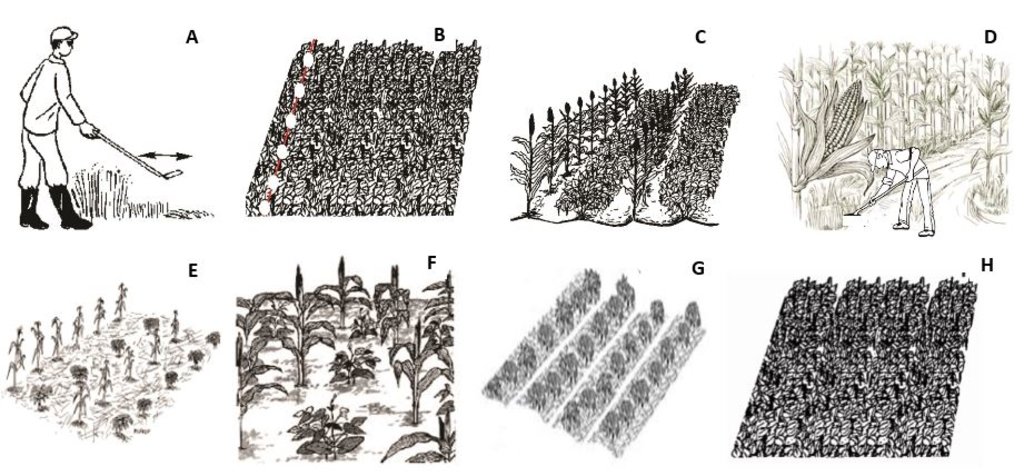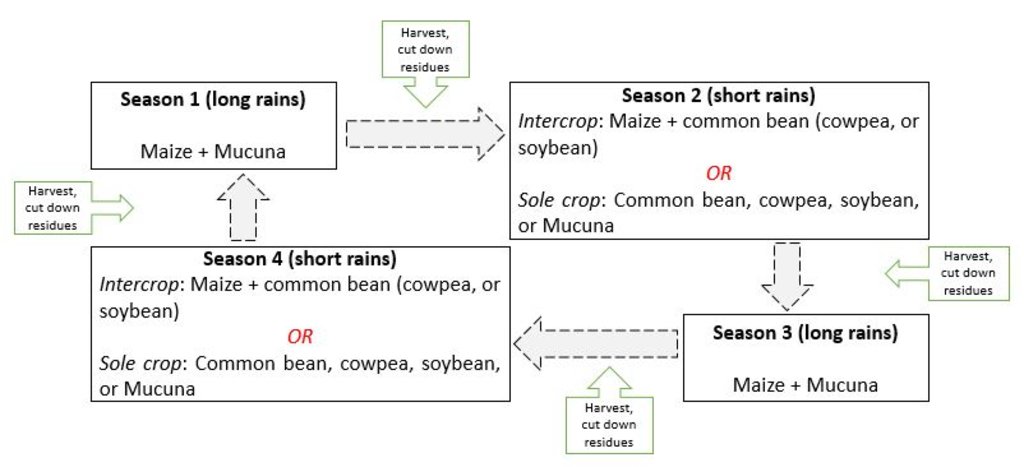Conservation agriculture for maize-legume systems with velvet bean as a dense cover crop [Kenia]
- Creación:
- Actualización:
- Compilador: Kennedy Were
- Editor: –
- Revisores: Rima Mekdaschi Studer, Tatenda Lemann
Kilimo hifadhi
technologies_5775 - Kenia
Visualizar secciones
Expandir todo Colapsar todos1. Información general
1.2 Detalles de contacto de las personas de referencia e instituciones involucradas en la evaluación y la documentación de la Tecnología
Especialista MST:
Especialista MST:
Especialista MST:
Especialista MST:
Nombre del proyecto que financió la documentación/ evaluación de la Tecnología (si fuera relevante)
GEF-UNEP-AGRA-KALRO SLM ProjectNombre del proyecto que financió la documentación/ evaluación de la Tecnología (si fuera relevante)
Carbon Benefits Project (CBP)Nombre de la(s) institución(es) que facilitaron la documentación/ evaluación de la Tecnología (si fuera relevante)
Kenya Agricultural and Livestock Research Organization (KALRO) - Kenia1.3 Condiciones referidas al uso de datos documentados mediante WOCAT
El compilador y la/s persona(s) de referencia claves aceptan las condiciones acerca del uso de los datos documentados mediante WOCAT:
Sí
1.4 Declaración de la sostenibilidad de la Tecnología descrita
¿La Tecnología aquí descrita resulta problemática en relación a la degradación de la tierra, de tal forma que no puede considerársela una tecnología sostenible para el manejo de la tierra?
No
2. Descripción de la Tecnología MST
2.1 Breve descripción de la Tecnología
Definición de la Tecnología:
Conservation agriculture for maize-legume systems with velvet bean (Mucuna pruriens) as a dense cover crop is being promoted in western Kenya to address the challenges of land degradation, low crop yields, low incomes, high production costs and climate change.
2.2 Descripción detallada de la Tecnología
Descripción:
Agriculture in western Kenya suffers from low productivity due to the degraded landscape. The soils are predominantly acidic and low in fertility, with the yields of food staples, such as maize and common bean averaging 1 ton/ ha and 5 tons/ ha, respectively. Consequently, the smallholder farmers have encroached into the adjacent Kakamega and Nandi forests in their quest for supplementary agro-ecosystem services and farm incomes. Degradation of the agro-resource base is underpinned by unsustainable practices carried out under conventional farming; for example, continuous cultivation with low nutrient inputs, mono-cropping, removal of crop residues and full tillage. Some of these practices enhance climate change by intensifying the emissions of greenhouse gases, such as carbon dioxide (CO2) into the atmosphere. Therefore, widespread adoption of conservation agriculture (CA) technology is being promoted to reduce the adverse impacts of conventional farming and enhance sustainable land management, environmental protection, and climate change mitigation and adaptation in 10 micro-catchments located within a 5-km radius from the edge of Kakamega and Nandi forests. The CA technology is characterized by the principles of minimum mechanical soil disturbance, maintenance of at least 30 percent permanent organic soil cover, diversified cropping through intercropping and crop rotations, and weed control. These principles have been adapted to the local conditions and needs.
The establishment of CA technology begins with land preparation. That is, the existing weeds and previous crop residues in the field are either slashed, or controlled through the application of appropriate herbicides. All the residues are retained on soil surface as opposed to burning, or removal in the conventional system. Land preparation is followed by planting, where the jab planter is used for precise placement of seeds and fertilizers in un-ploughed field, or within the established planting hills and rip lines to minimize soil tillage. This contrasts with conventional farming practice where a plough, or a hand hoe is used to till the entire field and establish the planting holes for placing seeds and fertilizers. A combination of cereal (maize – Zea mays L.) and legumes (common bean – Phaseolus vulgaris L., soybean - Glycine max, velvet bean – Mucuna pruriens and cowpea – Vigna unguiculata) are either intercropped, or rotated in the field each season to optimize the use of the available soil resources, including water, nutrients, and micro-organisms. The main cereal-legume association involves the establishment of Mucuna pruriens under maize as a dense cover crop. In this cropping system, Mucuna pruriens seeds are sown within a spacing of 1 m × 0.5 m where they grow and spread to completely cover the soil surface. As the cover crop grows, the leaves fall and decompose on the ground, enriching the soil’s nutrients, organic matter and fertility. The maize - Mucuna pruriens mix is rotated with either sole common bean, soybean and cowpea crop, or an intercrop of maize with any of the legumes. Weeding is carried out using either selective herbicides, or weed scrapers. When designing the intercropping and rotation plans, crop families (N-fixing vs. non-fixing), root depths (shallow vs. deep roots), and susceptibility to diseases, pests and weeds are all considered.
Generally, CA technologies have multiple benefits for farmers and the environment. In the context of the Kakamega-Nandi forest landscape, the CA plots with Mucuna pruriens as a dense cover crop have shown improved soil organic matter, soil structure and nutrient status. It is expected that this will reduce the use of fertilizers over time. Most farmers have also reported that reduced tillage and direct placement of inputs (seeds and fertilizers) save them time, money, fuel, labour and inputs. Aside from saving resources, reduced tillage will ultimately enhance soil living organisms and mitigate atmospheric CO2 emissions through the decrease in fuel consumption and soil disturbance. Moreover, farmers have observed that the maize established with Mucuna pruriens as a cover crop remains green and healthy for long during mid-season dry spells compared to those under mono-culture, or light mulch. This implies that the CA technology also increases water infiltration and soil water content; thus, acting as insurance against drought. The increase in water infiltration and soil moisture occurs because the dense Mucuna pruriens cover crop not only regulates the soil surface temperatures and evaporation, but also reduces surface runoff and exposure to wind erosion. In addition, farmers have witnessed the suppression of weeds, such as Striga hermonthica (witchweed) in plots under dense cover crop and diversified cropping. Besides, diversified cropping through rotations has reduced the incidences of insect pests and diseases, as well as the risk of crop failure during extreme weather conditions and pest infestations. Specifically, farmers have noticed that the CA plots under maize - Mucuna pruriens intercrop are less affected by the fall armyworm (Spodoptera frugiperda) compared to those under mono-culture. They have also noted that, in seasons of excessive rainfall, the maize intercropped with the common bean is usually harvested even when the common bean fails. Most importantly, these CA benefits have boosted maize yields by over 50 percent, meaning more food and income, and fewer forest encroachments.
Proper adoption of the CA technology by land users within the Kakamega-Nandi forest landscape is being hampered by several factors. Firstly, crop residues are inadequate due to competing uses, such as animal feed and fuel. At times, livestock is even allowed to graze on the stubble field, contravening the CA principles. Besides, some farmers have not fully embraced crop diversification and still grow maize throughout the seasons without rotation with other drought-tolerant cereals, such as sorghum and millet. Conventional ploughing is also quite entrenched. Further, some farmers still do not prefer Mucuna pruriens as a cover crop because of insufficient knowledge on the utilization of its inedible yields. Lastly, some farmers are finding it hard to access CA inputs and tools, such as the jab planters, weed scrapers, herbicides and seeds of Mucuna pruriens owing to either high prices, or shortages.
2.3 Fotografías de la Tecnología
2.4 Videos de la Tecnología
2.5 País/ región/ lugares donde la Tecnología fue aplicada y que se hallan comprendidos por esta evaluación
País:
Kenia
Región/ Estado/ Provincia:
Western region
Especifique más el lugar :
Kakamega-Nandi forest landscape
Especifique la difusión de la Tecnología:
- aplicada en puntos específicos/ concentrada en un área pequeña
¿El/los sitio(s) de la Tecnología se ubica(n) en un área de protección permanente?
No
Map
×2.6 Fecha de la implementación
Indique año de implementación:
2019
2.7 Introducción de la Tecnología
Especifique cómo se introdujo la Tecnología:
- durante experimentos/ investigación
- mediante proyectos/ intervenciones externas
Comentarios (tipo de proyecto, etc.):
Projects and research focusing mainly on advancing land degradation neutrality and agricultural productivity in the area
3. Clasificación de la Tecnología MST
3.1 Propósito(s) principal(es) de la Tecnología MST
- mejorar la producción
- reducir, prevenir, restaurar la degradación de la tierra
- preservar/ mejorar biodiversidad
- mitigar cambio climático y sus impactos
- crear impacto económico benéfico
3.2 Tipo(s) actuales de uso de la tierra donde se aplica la Tecnología
Mezcla de tipos de uso de tierras dentro de la misma unidad de tierras: :
Sí
Especifique el uso combinado de tierras (cultivos/ pastoreo/ árboles):
- Agropastoralismo (incluyendo cultivo-ganado integrados)

Tierras cultivadas
- Cosecha anual
Cosechas anuales - Especifique cultivos:
- cereales - maíz
- leguminosas y legumbres - frijoles
- leguminosas y legumbres - arvejas
- leguminosas y legumbres - soya
Sistema anual de cultivo:
Maíz/sorgo/ mijo en intercultivo con legumbres
Número de temporadas de cultivo por año:
- 2
Especifique:
Long rain season (March to May) and short rain season (October to December)
¿Se practica el intercultivo?
Sí
Si respondió que sí, especifique qué cultivos son intercultivados:
Maize and legumes (i.e., common bean, soybean and velvet bean – Mucuna pruriens)
¿Se practica la rotación de cultivos?
Sí
Si fuera el caso, especifique :
Maize and legumes (i.e., common bean, soybean and velvet bean – Mucuna pruriens)

Tierra de pastoreo
Pastoreo intensivo/ producción de forraje:
- Cortar y llevar/ cero pastoreo
- Pastoreo mejorado
Tipo de animal:
- cattle - dairy and beef (e.g. zebu)
¿Se practica el manejo integrado de cultivos - ganado?
Sí
Si fuera el caso, especifique :
Manure is used for fertilization and crop residues are used as cattle feed
Productos y servicios:
- manure as fertilizer/ energy production
- carne
- leche
- cueros/ pieles
- transporte/ de tiro
3.3 ¿Cambió el uso de tierras debido a la implementación de la Tecnología?
¿Cambió el uso de tierras debido a la implementación de la Tecnología?
- Sí (Por favor responda las preguntas de abajo referidas al uso de la tierra antes de implementar la Tecnología)
Mezcla de tipos de uso de tierras dentro de la misma unidad de tierras: :
Sí
Especifique el uso combinado de tierras (cultivos/ pastoreo/ árboles):
- Agropastoralismo (incluyendo cultivo-ganado integrados)

Tierras cultivadas
- Cosecha anual
Cosechas anuales - Especifique cultivos:
- cereales - maíz
Sistema anual de cultivo:
Maíz/sorgo/mijo de producción continua
¿Se practica el intercultivo?
No
¿Se practica la rotación de cultivos?
No

Tierra de pastoreo
Pastoreo intensivo/ producción de forraje:
- Cortar y llevar/ cero pastoreo
Tipo de animal:
- cattle - dairy and beef (e.g. zebu)
¿Se practica el manejo integrado de cultivos - ganado?
Sí
Si fuera el caso, especifique :
Manure is used for fertilization and crop residues are used as cattle feed
Productos y servicios:
- manure as fertilizer/ energy production
- carne
- leche
- cueros/ pieles
- transporte/ de tiro
3.4 Provisión de agua
Provisión de agua para la tierra donde se aplica la Tecnología:
- de secano
3.5 Grupo MST al que pertenece la Tecnología
- cobertura de suelo/ vegetal mejorada
- perturbación mínima del suelo
- manejo integrado de la fertilidad del suelo
3.6 Medidas MST que componen la Tecnología

medidas agronómicas
- A1: vegetación/ cubierta del suelo
- A2: materia orgánica/ fertilidad del suelo
- A3: Tratamiento de superficie del suelo
- A6: Manejo de residuos
A3: Diferencie sistemas de labranza:
A 3.2: Reduced tillage (> 30% soil cover)
A6: Especifique manejo de residuos:
A 6.4: retenido
3.7 Principales tipos de degradación de la tierra encarados con la Tecnología

erosión de suelos por agua
- Wt: pérdida de capa arable/ erosión de la superficie

erosión de suelos por viento
- Et: pérdida de capa arable

deterioro químico del suelo
- Cn: reducción de la fertilidad y contenido reducido de la materia orgánica del suelo (no ocasionados por la erosión)

deterioro físico del suelo
- Pc: compactación

degradación biológica
- Bl: pérdida de la vida del suelo

degradación del agua
- Ha: aridificación
3.8 Prevención, reducción o restauración de la degradación de la tierra
Especifique la meta de la Tecnología con relación a la degradación de la tierra:
- reducir la degradación de la tierra
4. Especificaciones técnicas, actividades de implementación, insumos y costos
4.1 Dibujo técnico de la Tecnología
Especificaciones técnicas (relacionadas al dibujo técnico):
The first technical drawing shows a typical farm under CA with various principles:
A - Clearance of weeds and previous crop residues through slashing in preparation for planting in season 1 (long rains). The residues are retained on the plot.
B - In a plot under total soil cover with Mucuna pruriens, maize seed and fertilizer are placed at the precise planting hills, denoted by the white circles along the red line, using a jab planter to minimize soil tillage.
C - Maize crop establishes under the dense cover of Mucuna pruriens.
D - Weeding of the maize crop is done using a weed scraper.
E & F - In season 2 (short rains), after harvesting maize in the previous maize – Mucuna cropping system and cutting down the residues, either a row intercropping system with alternate rows of maize and soybean (E), or maize and common bean (F) under maize straw mulch is established.
G & H - Alternatively, in season 2 (short rains), either sole common bean (cowpea, or soybean) production under maize straw mulch (G), or total soil cover with Mucuna pruriens (H) is established in the plot.
Autor:
Sam Koile, Kennedy Were & George Ayaga
Fecha:
31/05/2020
Especificaciones técnicas (relacionadas al dibujo técnico):
The second technical drawing is an illustration of a four season (2-year) rotation of maize, legumes and cover crop
Autor:
Kennedy Were, Sam Koile & George Ayaga
Fecha:
15/07/2020
4.2 Información general sobre el cálculo de insumos y costos
Especifique cómo se calcularon los costos e insumos:
- por área de Tecnología
Indique tamaño y unidad de área:
1 ha
Si usa una unidad de área local, indique el factor de conversión a una hectárea (ej. 1 ha = 2.47 acres): 1 ha =:
2.47 acres
otra / moneda nacional (especifique):
KES
Si fuera relevante, indique la tasa de cambio de dólares americanos a la moneda local (ej. 1 U$ = 79.9 Reales Brasileros): 1 U$ =:
107,08
Indique el costo promedio del salario de trabajo contratado por día:
300
4.3 Actividades de establecimiento
| Actividad | Momento (estación) | |
|---|---|---|
| 1. | Purchase of CA tools - jab planter, knapsack sprayer, protection gear, slasher, weed scraper, and gunny bag) | Initial stage |
4.4 Costos e insumos necesarios para el establecimiento
| Especifique insumo | Unidad | Cantidad | Costos por unidad | Costos totales por insumo | % de los costos cubiertos por los usuarios de las tierras | |
|---|---|---|---|---|---|---|
| Equipo | Jab planter | Piece | 2,0 | 1500,0 | 3000,0 | 100,0 |
| Equipo | Knapsack sprayer | Piece | 2,0 | 2500,0 | 5000,0 | 100,0 |
| Equipo | Protection gear | Piece | 2,0 | 1000,0 | 2000,0 | 100,0 |
| Equipo | Weed scraper | Piece | 2,0 | 500,0 | 1000,0 | 100,0 |
| Equipo | Slasher | Piece | 2,0 | 500,0 | 1000,0 | 100,0 |
| Equipo | Gunny bag | Piece | 50,0 | 50,0 | 2500,0 | 100,0 |
| Costos totales para establecer la Tecnología | 14500,0 | |||||
| Costos totales para establecer la Tecnología en USD | 135,41 | |||||
4.5 Actividades de establecimiento/ recurrentes
| Actividad | Momento/ frequencia | |
|---|---|---|
| 1. | Land preparation - Slashing | Initial stage |
| 2. | Preparing the planting hills and rip lines | Initial stage |
| 3. | Planting - placing seeds and fertilizer using jab planter | Initial stage |
| 4. | Herbicide application | Initial and growing stages |
| 5. | Pesticide application | Growing stage |
| 6. | Fertilizer application (top-dressing) | Growing stage |
| 7. | Harvesting, drying and shelling | Final stage |
4.6 Costos e insumos necesarios para actividades de mantenimiento/ recurrentes (por año)
| Especifique insumo | Unidad | Cantidad | Costos por unidad | Costos totales por insumo | % de los costos cubiertos por los usuarios de las tierras | |
|---|---|---|---|---|---|---|
| Mano de obra | Land preparation - slashing and herbicide application | Man day | 4,0 | 300,0 | 1200,0 | 100,0 |
| Mano de obra | Planting - preparing the planting hills and placing seeds and fertilizer | Man day | 38,0 | 300,0 | 11400,0 | 100,0 |
| Mano de obra | Top-dressing and pesticide application | Man day | 8,0 | 300,0 | 2400,0 | 100,0 |
| Mano de obra | Harvesting, shelling and drying | Man day | 30,0 | 300,0 | 9000,0 | 100,0 |
| Material para plantas | Maize seed | Kg | 20,0 | 250,0 | 5000,0 | 100,0 |
| Material para plantas | Legume seed | Kg | 8,0 | 250,0 | 2000,0 | 100,0 |
| Fertilizantes y biocidas | Planting fertilizer | Kg | 125,0 | 60,0 | 7500,0 | 100,0 |
| Fertilizantes y biocidas | Top-dressing fertilizer | Kg | 125,0 | 50,0 | 6250,0 | 100,0 |
| Fertilizantes y biocidas | Pesticide | Litre | 2,0 | 1250,0 | 2500,0 | 100,0 |
| Fertilizantes y biocidas | Herbicide | Litre | 5,0 | 875,0 | 4375,0 | 100,0 |
| Otros | Transport | Km | 5,0 | 1500,0 | 7500,0 | 100,0 |
| Indique los costos totales para mantenecer la Tecnología | 59125,0 | |||||
| Costos totales para mantener la Tecnología en USD | 552,16 | |||||
4.7 Factores más determinantes que afectan los costos:
Describa los factores más determinantes que afectan los costos:
1. Prevailing market prices of the inputs, equipment and labour.
5. Entorno natural y humano
5.1 Clima
Lluvia anual
- < 250 mm
- 251-500 mm
- 501-750 mm
- 751-1,000 mm
- 1,001-1,500 mm
- 1,501-2,000 mm
- 2,001-3,000 mm
- 3,001-4,000 mm
- > 4,000 mm
Especificaciones/ comentarios sobre la cantidad de lluvia:
Rainfall is bi-modal with the long rain season starting from March to May, and the short rains from October to December.
Zona agroclimática
- húmeda
- Sub-húmeda
mean annual temperature varies from 18 to 29° C
5.2 Topografía
Pendientes en promedio:
- plana (0-2 %)
- ligera (3-5%)
- moderada (6-10%)
- ondulada (11-15%)
- accidentada (16-30%)
- empinada (31-60%)
- muy empinada (>60%)
Formaciones telúricas:
- meseta/ planicies
- cordilleras
- laderas montañosas
- laderas de cerro
- pies de monte
- fondo del valle
Zona altitudinal:
- 0-100 m s.n.m.
- 101-500 m s.n.m.
- 501-1,000 m s.n.m
- 1,001-1,500 m s.n.m
- 1,501-2,000 m s.n.m
- 2,001-2,500 m s.n.m
- 2,501-3,000 m s.n.m
- 3,001-4,000 m s.n.m
- > 4,000 m s.n.m
Indique si la Tecnología se aplica específicamente en:
- no relevante
5.3 Suelos
Profundidad promedio del suelo:
- muy superficial (0-20 cm)
- superficial (21-50 cm)
- moderadamente profunda (51-80 cm)
- profunda (81-120 cm)
- muy profunda (>120 cm)
Textura del suelo (capa arable):
- mediana (limosa)
- fina/ pesada (arcilla)
Textura del suelo (> 20 cm debajo de la superficie):
- mediana (limosa)
- fina/ pesada (arcilla)
Materia orgánica de capa arable:
- media (1-3%)
- baja (<1%)
5.4 Disponibilidad y calidad de agua
Agua subterránea:
5-50 m
Disponibilidad de aguas superficiales:
mediana
Calidad de agua (sin tratar):
agua potable de mala calidad (requiere tratamiento)
La calidad de agua se refiere a:
agua subterránea y superficial
¿La salinidad del agua es un problema?
No
¿Se está llevando a cabo la inundación del área? :
No
5.5 Biodiversidad
Diversidad de especies:
- mediana
Diversidad de hábitats:
- mediana
5.6 Las características de los usuarios de la tierra que aplican la Tecnología
Sedentario o nómada:
- Sedentario
Orientación del mercado del sistema de producción:
- subsistencia (autoprovisionamiento)
- mixta (subsistencia/ comercial)
Ingresos no agrarios:
- menos del 10% de todos los ingresos
- 10-50% de todo el ingreso
Nivel relativo de riqueza:
- pobre
- promedio
Individuos o grupos:
- individual/ doméstico
Nivel de mecanización:
- trabajo manual
- tracción animal
Género:
- mujeres
- hombres
Edad de los usuarios de la tierra:
- personas de mediana edad
- ancianos
5.7 Área promedio de la tierra usada por usuarios de tierra que aplican la Tecnología
- < 0.5 ha
- 0.5-1 ha
- 1-2 ha
- 2-5 ha
- 5-15 ha
- 15-50 ha
- 50-100 ha
- 100-500 ha
- 500-1,000 ha
- 1,000-10,000 ha
- > 10,000 ha
¿Esto se considera de pequeña, mediana o gran escala (refiriéndose al contexto local)?
- pequeña escala
5.8 Tenencia de tierra, uso de tierra y derechos de uso de agua
Tenencia de tierra:
- individual, sin título
- individual, con título
Derechos de uso de tierra:
- individual
Derechos de uso de agua:
- comunitarios (organizado)
- individual
¿Los derechos del uso de la tierra se basan en un sistema legal tradicional?
Sí
5.9 Acceso a servicios e infraestructura
salud:
- pobre
- moderado
- bueno
educación:
- pobre
- moderado
- bueno
asistencia técnica:
- pobre
- moderado
- bueno
empleo (ej. fuera de la granja):
- pobre
- moderado
- bueno
mercados:
- pobre
- moderado
- bueno
energía:
- pobre
- moderado
- bueno
caminos y transporte:
- pobre
- moderado
- bueno
agua potable y saneamiento:
- pobre
- moderado
- bueno
servicios financieros:
- pobre
- moderado
- bueno
6. Impactos y comentarios para concluir
6.1 Impactos in situ demostrados por la Tecnología
Impactos socioeconómicos
Producción
producción de cultivo
Cantidad antes de MST:
24 bags/ ha
Cantidad luego de MST:
43 bags/ ha
Comentarios/ especifique:
This can be attributed to the multiple benefits of the CA technology, such as improved soil organic matter content and nutrient status. Note: A standard bag weighs 90 kgs.
calidad de cultivo
Comentarios/ especifique:
The multiple benefits of the CA technology, such as improved soil conditions and alleviation of pests and diseases, not only increased crop production (yields), but also the quality of the crops.
producción de forraje
Comentarios/ especifique:
Increased crop production also means increased fodder production because the crop residues are partly used as animal feed
calidad de forraje
Comentarios/ especifique:
Increased crop quality also implies increased fodder quality because the crop residues are partly used as animal feed
riesgo de fracaso de producción
Comentarios/ especifique:
Specifically,
- the maize established with Mucuna pruriens as a cover crop have remained green and healthy for long during mid-season dry spells. The CA technology increases water infiltration and soil moisture because the dense cover crop not only regulates the soil surface temperatures and evaporation, but also reduces surface runoff
- the CA plots under maize - Mucuna pruriens inter-crop have been less affected by the fall armyworm (Spodoptera frugiperda).
- in seasons of excessive rainfall, the maize intercropped with the common bean has been harvested even when the common bean fails.
diversidad de producto
Comentarios/ especifique:
Farmers not only grow maize, but also mix or rotate it with common bean, soybean and cowpea
manejo de tierras
Comentarios/ especifique:
Operations such as precise and direct placement of inputs and minimum tillage have simplified land management
Ingreso y costos
gastos en insumos agrícolas
Comentarios/ especifique:
Expenses on inputs, such as herbicides and fertilizers increased marginally, because the conventional farming practice had been characterized by low inputs; however, with improved soil organic matter, soil structure and nutrient status, as well as reduced incidences of pest, diseases and weeds, it is expected that the use of these inputs will diminish over time
ingreso agrario
Comentarios/ especifique:
Increased crop production means, more surplus and incomes
diversidad de fuentes de ingreso
Comentarios/ especifique:
Diversified cropping enables the farmers to get income from maize, common bean, soybean and cowpea production
carga de trabajo
Comentarios/ especifique:
Reduced tillage has subsequently decreased the farmers' workload because they no longer have to plough the entire field
Impactos socioculturales
seguridad alimentaria/ autosuficiencia
Comentarios/ especifique:
Increased crop production means more food and less hungry periods. The legumes also provide a good source of protein to the farmers' households
instituciones comunitarias
Comentarios/ especifique:
The common interest groups have been greatly involved in the selection of the CA technologies. The strengthening of the community institutions has been done for sustainability and to allow sensitization of the technology to the wider population in the landscape. Some of thaccess by the communities. e promotion approaches have been on-farm demonstrations and training of trainers (ToTs), which have involved and empowered different farmer groups within the communities. Seed producers have also been trained to multiply seeds of specific crops, such as Mucuna pruriens for ease of access
MST/ conocimiento de la degradación de la tierra
Comentarios/ especifique:
On-farm demonstrations of the CA technology and the training of trainers (ToTs) have empowered different stakeholders within the communities with sufficient SLM/ land degradation knowledge
Impactos ecológicos
Ciclo de agua/ escurrimiento de sedimento
escurrimiento superficial
Comentarios/ especifique:
The dense Mucuna pruriens cover crop reduces surface runoff
nivel freático/ acuífero
Comentarios/ especifique:
There has been increase in water infiltration and soil water content because the dense Mucuna pruriens cover crop not only regulates the soil surface temperatures and evaporation, but also reduces surface runoff. This recharges the aquifer
evaporación
Comentarios/ especifique:
The dense Mucuna pruriens cover crop regulates both the soil surface temperatures and evaporation
Suelo
humedad del suelo
Comentarios/ especifique:
The increase in soil water content occurs because the dense Mucuna pruriens cover crop not only regulates the soil surface temperatures and evaporation, but also reduces surface runoff
cubierta del suelo
Comentarios/ especifique:
The dense Mucuna pruriens completely covers the soil surface, and is left on the ground even after the harvesting of maize
pérdida de suelo
Comentarios/ especifique:
The dense Mucuna pruriens cover crop reduces surface runoff and exposure to wind erosion
acumulación de suelo
Comentarios/ especifique:
Accumulation of soil organic carbon has occurred because the dense cover crop has a higher net primary productivity and sheds more leaves on the ground, resulting in more inputs of detritus to the soil. Similarly, retention of the large amount of crop residues especially those obtained from the leguminous crops has increased the inputs of carbon and nitrogen to the soil.
encostramiento/ sellado de suelo
Comentarios/ especifique:
The cover crop, minimum tillage and crop residues have protected the soil from the impact of raindrops, improved the surface soil structure and aggregate stability by increasing the organic matter content in the soil and stimulated soil biological activity, making the soil resistant to crusting
compactación de suelo
Comentarios/ especifique:
Reduced tillage or zero tillage has minimized farm land activities, e.g, ploughing which often result in compaction of soil. Incorporation of deep rooted crops with shallow rooted crops has also helped to break the various soil layers, thus hindering compaction. In addition, accumulation of soil organic carbon has improved soil biological activities that help to reduce soil compaction, through continuous burrowing.
ciclo/ recarga de nutrientes
Comentarios/ especifique:
As the dense cover crop grows, the leaves fall and decompose on the ground, enriching the soils with nitrogen and organic matter
materia orgánica debajo del suelo C
Comentarios/ especifique:
As the dense cover crop grows, the leaves fall and decompose on the ground, with organic matter additions.
Biodiversidad: vegetación, animales
biomasa/ sobre suelo C
Comentarios/ especifique:
The dense cover crop has higher net primary productivity/ above-ground biomass C, which is left when the maize crop is harvested.
diversidad vegetal
Comentarios/ especifique:
Farmers grow a mix of crops under the diverse cropping principle, which has increased plant diversity
especies invasoras extrañas
Comentarios/ especifique:
Farmers have witnessed the suppression of weeds, such as Striga hermonthica (witchweed) in plots under dense cover crop and diversified cropping.
especies benéficas
Comentarios/ especifique:
Reduced tillage and accumulation of soil organic carbon have increased beneficial soil living organisms, such as the earthworms.
control de pestes/ enfermedades
Comentarios/ especifique:
Diversified cropping through rotations has reduced the incidences of insect pests and diseases through disruption of pest and disease cycles. Specifically, farmers have noticed that the CA plots under maize - Mucuna pruriens intercrop are less affected by the fall armyworm (Spodoptera frugiperda)
Reducción de riesgos de desastres y riesgos climáticos
impactos de sequías
Comentarios/ especifique:
The maize established with Mucuna pruriens as a cover crop has remained green and healthy for long during mid-season dry spells. This implies that the CA technology also increases water infiltration and soil water content; thus, acting as insurance against drought.
emisión de carbono y gases de invernadero
Comentarios/ especifique:
Reduced tillage mitigates atmospheric carbon dioxide emissions through the decrease in fossil fuel consumption and soil disturbance. Crop residues are also retained in the field and not burnt; hence, reducing emission of carbon.
6.2 Impactos fuera del sitio demostrados por la Tecnología
impacto de gases de invernadero
6.3 Exposición y sensibilidad de la Tecnología al cambio climático gradual y a extremos relacionados al clima/ desastres (desde la percepción de los usuarios de tierras)
Cambio climático gradual
Cambio climático gradual
| Estación | Incremento o reducción | ¿Cómo es que la tecnología soporta esto? | |
|---|---|---|---|
| temperatura anual | incrementó | bien | |
| lluvia anual | incrementó | bien |
Extremos (desastres) relacionados al clima
Desastres climatológicos
| ¿Cómo es que la tecnología soporta esto? | |
|---|---|
| sequía | bien |
Desastres biológicos
| ¿Cómo es que la tecnología soporta esto? | |
|---|---|
| enfermedades epidémicas | bien |
| insectos/ infestación de gusanos | bien |
6.4 Análisis costo-beneficio
¿Cómo se comparan los beneficios con los costos de establecimiento (desde la perspectiva de los usuarios de tierra)?
Ingresos a corto plazo:
ligeramente positivo
Ingresos a largo plazo:
positivo
¿Cómo se comparan los beneficios con los costos de mantenimiento/ recurrentes (desde la perspectiva de los usuarios de tierra)?
Ingresos a corto plazo:
ligeramente positivo
Ingresos a largo plazo:
positivo
Comentarios:
For example, it is expected that the associated improvement in soil organic matter, soil structure and nutrient status will reduce the use of fertilizers in the long term.
6.5 Adopción de la Tecnología
- 1-10%
De todos quienes adoptaron la Tecnología, ¿cuántos lo hicieron espontáneamente, por ej. sin recibir nada de incentivos/ materiales:
- 51-90%
6.6 Adaptación
¿La tecnología fue modificada recientemente para adaptarse a las condiciones cambiantes?
No
6.7 Fuerzas/ ventajas/ oportunidades de la Tecnología
| Fuerzas/ ventajas/ oportunidades desde la perspectiva del usuario de la tierra |
|---|
| Maize established with Mucuna pruriens as a dense cover crop is not adversely affected by the fall army worm (Spodoptera frugiperda) |
| Reduced tillage saves time, money and energy, while the direct placement of inputs (seeds and fertilizers) minimizes wastage. The saved resources can be used to engage in other income-generating activities |
| Maize established with Mucuna pruriens as a dense cover crop remains green and healthy for long during mid-season dry spells |
| Weeds, such as Striga hermonthica (witchweed) are suppressed in plots under dense cover crop and diversified cropping (rotations and inter-crops) |
| In seasons of excessive rainfall, the maize intercropped with the common bean is usually harvested even when the common bean fails |
| The CA technology has boosted maize yields, meaning more food and income, and reduced cost of feeding the family |
| Fuerzas/ ventajas/ oportunidades desde la perspectiva del compilador o de otra persona de referencia clave |
|---|
| The CA plots with Mucuna pruriens as a dense cover crop have improved soil organic matter, soil structure and nutrient status |
| Reduced tillage has enhanced soil living organisms, such as earthworms and decreased fuel consumption and soil disturbance; hence, mitigating atmospheric carbon dioxide emissions and storing carbon in soils |
| The CA technology has increased water infiltration and soil water content (moisture); thus, acting as insurance against drought |
| Diversified cropping through rotations has reduced the incidences of insect pests and diseases, as well as the risk of crop failure during extreme weather conditions and pest infestations |
6.8 Debilidades/ desventajas/ riesgos de la Tecnología y formas de sobreponerse a ellos
| Debilidades/ desventajas/ riesgos desde la perspectiva del usuario de la tierra | ¿Cómo sobreponerse a ellas? |
|---|---|
| The Mucuna pruriens used as a dense cover crop intertwines on maize crop, which might increase manual labour | Promote other erect cover crops like the lablab bean (Dolichos lablab), Desmodium and Canavalia that will have less effect on the cereal crop established |
| The yields of Mucuna pruriens used as a dense cover crop are not edible |
- Extension agents and Trainer of Trainees (ToTs) to equip farmers with knowledge on the options available for utilizing Mucuna pruriens yields other than being a cover crop - Promote other erect cover crops like the lablab bean (Dolichos lablab), Desmodium and Canavalia |
| Residue retention reduces the availability of fodder and fuel materials | Adopt an agro-forestry system with tree species that can provide alternative source of fodder and fuel |
| The critical CA inputs and implements, such as the jab planters, weed scrapers, herbicides and Mucuna seeds are hard to access |
- Incentivize and train the local fabricators to fabricate affordable CA tools - Subsidize CA inputs, such as fertilizer and herbicides - Facilitate access to credit - Train more seed producers to multiply the seeds of Mucuna pruriens |
| Debilidades/ desventajas/ riesgos desde la perspectiva del compilador o de otra persona de referencia clave | ¿Cómo sobreponerse a ellas? |
|---|---|
| Agro-ecosystem contamination through use of herbicides and inorganic fertilizers | Use the right doses of herbicides and fertilizers |
7. Referencias y vínculos
7.1 Métodos/ fuentes de información
- visitas de campo, encuestas de campo
- entrevistas con usuarios de tierras
- entrevistas con especialistas/ expertos en MST
¿Cuándo se compilaron los datos (en el campo)?
31/05/2020
7.4 Comentarios generales
Simple and clear.
Vínculos y módulos
Expandir todo Colapsar todosVínculos
No hay vínculos
Módulos
No se hallaron módulos



